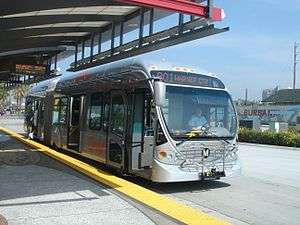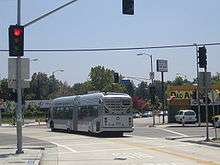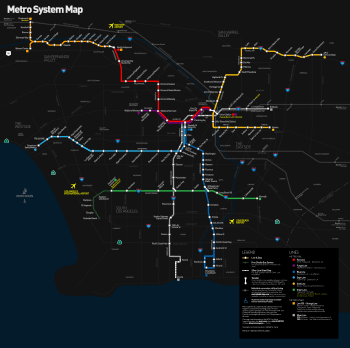Los Angeles Metro Busway
 | |||
 | |||
| Overview | |||
|---|---|---|---|
| Locale | Los Angeles County, California | ||
| Transit type | Bus rapid transit | ||
| Number of lines | 2 | ||
| Number of stations | 28 | ||
| Daily ridership | 42,334 (average weekday, May 2016)[1] | ||
| Operation | |||
| Began operation | 2005 | ||
| Operator(s) | Los Angeles County Metropolitan Transportation Authority (Metro) | ||
| Technical | |||
| System length | 60 mi (96.6 km) | ||
| |||
Metro Busway (previously known as Metro Liner and Metro Transitway), is a system of limited-stop bus services with bus rapid transit (BRT) features that operate primarily along exclusive or semi-exclusive roadways known locally as a "busway" or "transitway." There are currently two lines in the system, the Orange Line in the San Fernando Valley, and the Silver Line between El Monte, Downtown Los Angeles and San Pedro. The Los Angeles County Metropolitan Transportation Authority (Metro) operates the system.
The first route to open was the Orange Line, a BRT service which began operating on October 29, 2005, and runs along the exclusive Orange Line Busway. The Silver Line, a freeway express route which runs along the pre-existing Harbor Transitway & El Monte Busway, began operating on December 13, 2009.
Metro Busway routes are designed to mimic Metro Rail services, in both the vehicle's design and their operation. Buses on both lines use a silver livery (similar to the one used on Metro Rail), passengers can board at any door, and vehicles receive priority at intersections. Like Metro Rail, Metro Busway operates on a proof-of-payment system, and passengers who have a fare product loaded onto a TAP card can board from any door. TAP cards can be purchased at ticket vending machines (TVMs) located at most stations.
Current System
Lines
Metro Busway lines are named after colors and designated with colored squares. These colors and square icons are used to distinguish the lines on Metro's maps. Metro also uses colors for its Metro Rail lines but designates rail lines with colored circle icons.
Two Metro Busway lines operate in Los Angeles County:[2]
| Line name | Opening[2] | Length[2] | Stations[2] | Termini |
|---|---|---|---|---|
| 2005 | 22 mi (35 km) | 17 | North Hollywood (east) Chatsworth (north) | |
| 2009[lower-alpha 1] | 38 mi (61 km) | 11 | El Monte Station (east) Harbor Gateway Transit Center (south) San Pedro (south) |
- ↑ While the roadways the Silver Line operates on opened as the El Monte Busway in 1973 and as the Harbor Transitway in 1996, the Silver Line was not established as a through route until 2009.
Corridors
These services operate on three corridors (in addition to city streets, where necessary):
Facilities
These are Metro's maintenance facilities that facilitates the Liner buses:
- Division 8 (West Valley)
- Division 9 (El Monte/San Gabriel Valley)
- Division 18 (South Bay)
History
The following table shows the timeline of BRT expansions:
| Segment description | Date opened | Line(s) | Endpoints | # of new stations |
Busway length (miles) |
|---|---|---|---|---|---|
| Metro Orange Line initial segment | October 29, 2005 | North Hollywood station to Warner Center Transit Hub | 13 | 14 | |
| Canoga station | December 27, 2006 | Canoga station | 1 [Note 1] |
− | |
| Metro Silver Line initial segment | December 13, 2009 | El Monte Station to Harbor Gateway Transit Center | 8 | 26 | |
| 37th Street/USC station | December 12, 2010 | 37th Street/USC station | 1 [Note 2] |
− | |
| Metro Orange Line Chatsworth Extension | June 30, 2012 | Canoga station to Chatsworth station | 4 | 4 | |
| Metro Silver Line San Pedro Extension | December 13, 2015 | Harbor Gateway Transit Center to San Pedro (Pacific/21st Street) | 2 | 8 | |
| Warner Center Shuttle | June 24, 2018 | Canoga to Warner Center segment removed | (1) [Note 3] |
− | |
| 28 | 44 | ||||
Notes:
- ↑ Canoga was an infill station on the Metro Orange Line, which opened one year later in 2006. The station was built to provide a parking lot near the Warner Center western terminus.
- ↑ When the Metro Silver Line station opened in 2009, buses did not serve the existing 37th Street/USC station due to detours from the construction of the Metro Expo Line. Service to the station was added one year later in 2010.
- ↑ The Canoga to Warner Center segment was removed and replaced with a high-frequency shuttle route that serves a larger area of the Warner Center area.
Gallery
 Metro Silver Line bus at Slauson Station.
Metro Silver Line bus at Slauson Station.- Metro Silver Line bus with wheelchair ramp extended at Harbor Freeway Station.
- Metro Silver Line arriving at LAC/USC Medical Center Station.
- Metro Orange Line bus at Chatsworth Station.
- Metro Orange Line route map inside a bus.
- Interior of a Metro Orange Line bus.
- North Hollywood Orange Line Station platform.
- Metro Silver Line departing Slauson Station.
 Metro Silver Line 950X Express layover in San Pedro
Metro Silver Line 950X Express layover in San Pedro Orange Line bus on the busway crossing Burbank Boulevard and Fulton Avenue.
Orange Line bus on the busway crossing Burbank Boulevard and Fulton Avenue. A look at the elevated Harbor Transitway that the Metro Silver Line operates on.
A look at the elevated Harbor Transitway that the Metro Silver Line operates on.
| Wikimedia Commons has media related to LACMTA Bus Rapid Transit. |
See also
References
- ↑ "Ridership Statistics". Los Angeles County Metropolitan Transportation Authority. Retrieved June 11, 2016.
- 1 2 3 4 "Facts At A Glance". Metro. Retrieved June 11, 2016.

